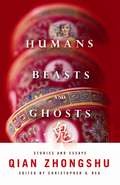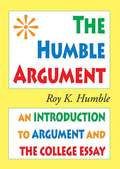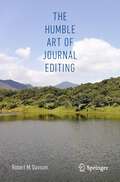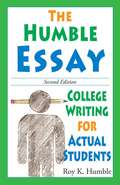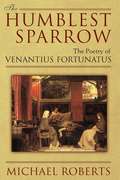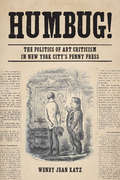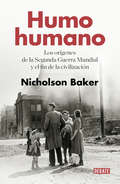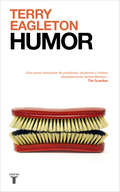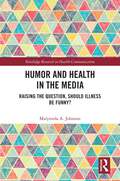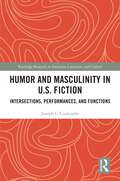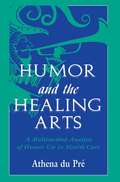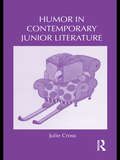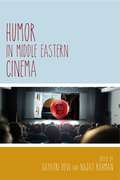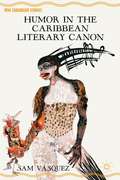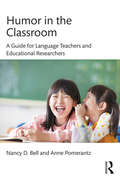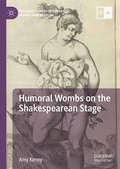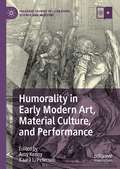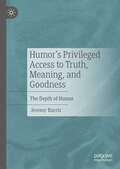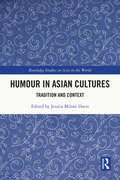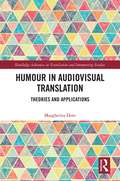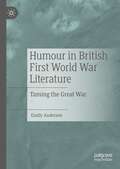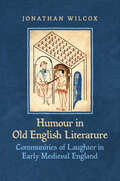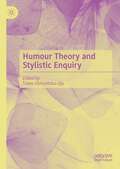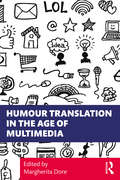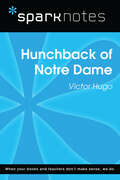- Table View
- List View
Humans, Beasts, and Ghosts: Stories and Essays (Weatherhead Books on Asia)
by Zhongshu QianQian Zhongshu was one of twentieth-century China's most ingenious literary stylists, one whose insights into the ironies and travesties of modern China remain stunningly fresh. Between the early years of the Second Sino-Japanese War (1937-1945) and the Communist takeover in 1949, Qian wrote a brilliant series of short stories, essays, and a comedic novel that continue to inspire generations of Chinese readers.With this long-awaited translation, English-language readers can immerse themselves in the invention and satirical wit of one of the world's great literary cosmopolitans. This collection brings together Qian's best short works, combining his iconoclastic essays on the "book of life" from Written in the Margins of Life (1941) with the four masterful short stories of Human, Beast, Ghost (1946). His essays elucidate substantive issues through deceptively simple subjects-the significance of windows versus doors, for example, or the blind spots of literary critics-and assert the primacy of critical and creative independence. His stories blur the boundaries between humans, beasts, and ghosts as they struggle through life, death, and resurrection. Christopher G. Rea situates these works within China's wartime politics and Qian's literary vision, highlighting significant changes that Qian Zhongshu made to different editions of his writings and providing unprecedented insight into the author's creative process.
The Humble Argument: An Introduction To Argument And The College Essay
by Roy K. HumbleThis down-to-earth textbook introduces argumentative writing in everyday language so that non-majors are more likely to understand these ideas and then put them to practical use. It is also the only rhetoric textbook in the world with a sense of humor.
The Humble Art of Journal Editing
by Robert M. DavisonThe publication of scholarly research is both a major driver of social progress and a significant industry in its own right. Scholarly research is the focus of attention for countless numbers of scholars globally and a key measure of scholarly excellence. Much has been written about the conduct of research that is designed to help scholars attain appropriate standards of rigor and relevance, and indeed craft their research outputs in ways appropriate for different venues, notably as journal articles, conference papers, book chapters, and books. However, although scholarly researchers fulfill roles other than as authors, for instance as journal reviewers and editors, there is a dearth of consolidated information about the nature of editorial work. Drawing on over two decades of experience in editing scholarly journals, the author offers a more systematic guide to scholarly journal editing.The book begins with an introduction to the art of scholarly journal editing,the nature of that art (Chapter 1), and an examination of editorial promulgation of cultural values of scholarly journals with an emphasis on responsible research (Chapter 2). Chapter 3 examines the many issues associated with sourcing content, and opines on the novelty, breadth, and depth of research, including discussions of indigenous theorization, serendipity, iconoclastic research, and the value of special issues. Chapter 4 deals with the review process and offers advice for formulating effective reviewer guidelines that lead to constructive and developmental advice for authors. The next two chapters discuss the audience of the journal as well as publisher relations. Finally, the book is concluded with thoughts and recommendations about emerging challenges, such as the ethics of AI tools (like ChatGPT), predatory journals, and the open-access movement.Offering a practical guide to editing scholarly journals, this book will be a key resource for scholars making the leap from researcher to editor, regardless of discipline.
The Humble Essay (Second Edition)
by Roy K. HumbleThis composition textbook introduces college writing in everyday language so that non-majors are more likely to actually read these chapters, understand the ideas, and then put those ideas to good use.
The Humblest Sparrow: The Poetry of Venantius Fortunatus
by Michael RobertsA long-awaited study of the poetry of Venantius Fortunatus
Humbug!: The Politics of Art Criticism in New York City's Penny Press
by Wendy Jean KatzApproximately 300 daily and weekly newspapers flourished in New York before the Civil War. A majority of these newspapers, even those that proclaimed independence of party, were motivated by political conviction and often local conflicts. Their editors and writers jockeyed for government office and influence. Political infighting and their related maneuvers dominated the popular press, and these political and economic agendas led in turn to exploitation of art and art exhibitions. Humbug traces the relationships, class animosities, gender biases, and racial projections that drove the terms of art criticism, from the emergence of the penny press to the Civil War.The inexpensive “penny” papers that appeared in the 1830s relied on advertising to survive. Sensational stories, satire, and breaking news were the key to selling papers on the streets. Coverage of local politicians, markets, crime, and personalities, including artists and art exhibitions, became the penny papers’ lifeblood. These cheap papers, though unquestionably part of the period’s expanding capitalist economy, offered socialists, working-class men, bohemians, and utopianists a forum in which they could propose new models for American art and society and tear down existing ones.Arguing that the politics of the antebellum press affected the meaning of American art in ways that have gone unrecognized, Humbug covers the changing politics and rhetoric of this criticism. Author Wendy Katz demonstrates how the penny press’s drive for a more egalitarian society affected the taste and values that shaped art, and how the politics of their art criticism changed under pressure from nativists, abolitionists, and expansionists. Chapters explore James Gordon Bennett’s New York Herald and its attack on aristocratic monopolies on art; the penny press’s attack on the American Art-Union, an influential corporation whose Board purchased artworks from living artists, exhibited them in a free gallery, and then distributed them in an annual five-dollar lottery; exposés of the fraudulent trade in Old Masters works; and the efforts of socialists, freethinkers, and bohemians to reject the authority of the past.
Humo humano: Los orígenes de la Segunda Guerra Mundial y el fin de la civilización
by Nicholson BakerUn libro inolvidable que tendrá un profundo efecto sobre nuestra visión de los acontecimientos históricos que culminaron en la Segunda Guerra Mundial y que contiene un sentido lamento por la irreparable pérdida que la humanidad se ha causado a sí misma. No es fácil aplicar una luz distinta a acontecimientos muy conocidos, pero eso es lo que logra Nicholson Baker en esta extraordinaria historia de los orígenes de la Segunda Guerra Mundial. A partir de fragmentos extraídos de periódicos y revistas de la época, discursos radiofónicos, panfletos, diarios y libros de memorias, entre otras fuentes, ordenados cronológicamente, Baker crea un mosaico de momentos decisivos, de barbarie, sufrimiento y compasión, de iluminadores destellos sobre escenas cotidianas e históricas. Una obra coral que, setenta años después, nos deja oír las voces de los líderes políticos y sus opositores, escritores, periodistas, militares y pacifistas, testimonios que ilustran de manera conmovedora el imparable y horrible avance hacia la guerra global y el holocausto. Elogiado por la crítica y los lectores por su capacidad de observación y su límpida prosa, Baker ha creado una narración que se desarrolla elegante, trágica y convincentemente. Reseñas:«Este libro absolutamente extraordinario -imposible de abandonar, imposible de olvidar- podría convertirse en el argumento más convincente en favor de la paz jamás construido. Este inventario meticulosamente seleccionado por Nicholson Baker muestra con asombroso y fascinante detalle el imparable descenso de la humanidad hacia la locura de la guerra.»Simon Winchester «Lentamente, a medida que lees, como consecuencia de la variedad en el tono y de la naturaleza trágica o terrible de la cita, así como de lo certero de su elección, Humo humano se vuelve apasionante y fascinante. Sin embargo, las cuestiones que Baker quiere plantear y el descarnado estilo que emplea para hacerlo, hacen de su libro una contribución seria y convencida al debate sobre el pacifismo. Ha creado un apasionante y elocuente ataque a la idea de que la elección deliberada de objetivos civiles pueda estar nunca justificada.»Colm Tóibín, The New York Times «Baker se vuelve especialmente interesante y provocativo al intentar demostrar que los terribles horrores del nazismo reafirman la postura pacifista.»Piers Brendon, The Guardian «Un libro que me ha encantado. Fascinante, sobrecogedor, instructivo, apasionante.»A.C. Grayling, The Times «Un fascinante y audaz experimento histórico literario, hay que aplaudir la originalidad y sutileza de su enfoque. Humo humano merece una entusiasta acogida.»Geoff Dyer, The Financial Times «Un texto coral en el que son los protagonistas quienes toman la palabra. [...]El resultado es perturbador, como si, de pronto, hubieran sido convocados a escena todos los silencios, todos los equívocos imprescindibles para que la historia de la II Guerra Mundial se pueda seguir contando como hasta ahora.»José María Ridao, El País
Humor
by Terry EagletonUN PASEO POR LOS LUGARES FUNDAMENTALES QUE OCUPA EL HUMOR EN LA CULTURA OCCIDENTAL, CON EL GUÍA MÁS AUTORIZADO (Y GRACIOSO). ¿Por qué nos reímos? ¿Qué ganamos con tanta carcajada? ¿Es el humor un agente subversivo o un remedio para las tensiones? ¿Cómo definir el ingenio? Escrito por un reconocido maestro de la comedia, este libro es una muestra perfecta de la naturaleza del humor y de sus funciones. Armado de agudas ocurrencias y un buen puñado de excelentes chistes, examina con mirada crítica las principales teorías del humor, como la idea de que este brota de la incongruencia o de que es el reflejo de una forma ligeramente sádica de sentimiento de superioridad con respecto a los demás. Terry Eagleton nos guía a las entrañas del humor basándose en una amplia gama de fuentes literarias y filosóficas, acompañado de Aristóteles, Rabelais, Hobbes y Freud, entre muchos otros, pero apoyándose también en ejemplos como los Monty Python o la stand-up comedyy deteniéndose en los mecanismos psicoanalíticos que subyacen al humor y en su evolución social y política a lo largo de los siglos. La crítica ha dicho...«Una prosa rebosante de paradojas, vituperios y chistes absolutamente desternillantes.»The Guardian «Si Terry Eagleton no existiera habría que inventarlo.»Simon Critchley «Una introducción concisa y divertida, con un análisis sensato del papel contradictorio del humor en la política. Eagleton es un guía ingenioso y tenaz, además de tremendamente gracioso.»Harper's «Delicioso y admirable. Cada frase es sencilla pero aporta una idea nueva. Se puede abordar como una lectura rápida y divertida, o como una lectura sosegada para explorar las profundidades ocultas que acechan detrás de cada nuevo ejemplo. Una espléndida puerta de entrada al tema.»Popmatters
Humor and Health in the Media: Raising the Question, Should Illness be Funny? (Routledge Research in Health Communication)
by Malynnda A. JohnsonExamining popular media portrayals of various health topics, this book offers a critical analysis of how those mediated messages can impact, for good or ill, people’s physical and mental health.Looking specifically at how various depictions of health topics have both aided in the normalization of health topics such as neurodiversity and HIV while also critiquing the dissemination of misinformation on these same topics, this book offers insight into the ways in which humorous content can both help and hurt. The author draws on a critical analysis of popular media including shows, social media, and stand-up specials, as well as interviews with those who use humor within health settings, such as Red Nose Docs, comedians who focus on their own health issues.This insightful study will interest scholars and students of health in popular culture as well as health communication, media studies, public health administration, and health policy.
Humor and Masculinity in U.S. Fiction: Intersections, Performances, and Functions (Routledge Research in American Literature and Culture)
by Joseph L. CoulombeHumor and Masculinity in U.S. Fiction offers a pragmatic and theoretically informed model for analyzing how humor and gender intersect in key U.S. texts, bringing much-needed attention to the complex ways that humor can support and/or subvert reductive masculine codes and behaviors. Its argument builds upon three major humor theories – the incongruity theory, superiority theory, and relief theory – to analyze how humor is used to negotiate the shifting constructions of masculinity and manhood in American culture and literature. Focusing on explicit textual references to joking, pranks, and laughter, Humor and Masculinity in U.S. Fiction offers well-supported, original interpretations of works by Mark Twain, Owen Wister, Dorothy Parker, Zora Neale Hurston, Joseph Heller, Philip Roth, and Sherman Alexie. The primary goal of Humor and Masculinity in U.S. Fiction is to understand the multiple ways that humor performs and interrogates masculinity in seminal U.S. texts.
Humor and the Healing Arts: A Multimethod Analysis of Humor Use in Health Care (Routledge Communication Series)
by Athena du PréOffering a social scientific look at humor's role in medical transactions, this volume is based on extensive field study in seven medical settings. It includes excerpts from dozens of actual conversations between patients and caregivers. Analysis of these episodes reveals that humor is a practical tool used to meet many medical objectives. It is used by patients to good-naturedly complain and to campaign for more personal attention, and by caregivers to get attention, make amends, insist on unpleasant routines, and establish rapport. Examining humor from many angles, the book begins with a phenomenological analysis of the essence of funny. This section describes what makes some things funny but not others, and how to distinguish between potentially funny and unfunny episodes in medical situations. From an ethnographic perspective, joking around is shown to be a persuasive element of medical culture. Examples illustrate how patients and caregivers use humor to negotiate the dialectics between helping and hurting, and individuality and compliance. Additionally, a close-up look at three medical transactions shows how humor is used to help a physical therapy patient overcome fear and queasiness, reduce the embarrassment of a mammography, and defuse a potential conflict between a student aide and a young patient. A final section examines techniques for initiating conversational humor. In sum, this volume provides an intimate and realistic look at medical conversations as they are conducted every day. It serves as a valuable complement to health communication texts and offers information of interest to health communication scholars, healthcare practitioners, and anyone interested in the effects and techniques of conversational humor. Richly grounded in naturally occurring data, the book can be understood and used effectively by both scholars and practitioners.
Humor in Contemporary Junior Literature (Children's Literature and Culture)
by Julie CrossIn this new book, Julie Cross examines the intricacies of textual humor in contemporary junior literature, using the tools of literary criticism and humor theory. Cross investigates the dialectical paradoxes of humor and debunks the common belief in oppositional binaries of ‘simple’ versus ‘complex’ humor. The varied combinations of so-called high and low forms of humor within junior texts for young readers, who are at such a crucial stage of their reading and social development, provide a valuable commentary upon the culture and values of contemporary western society, making the book of considerable interest to scholars of both children’s literature and childhood studies. Cross explores the ways in which the changing content, forms and functions of the many varied combinations of humor in junior texts, including the Lemony Snickett series, reveal societal attitudes towards young children and childhood. The new compounds of seemingly paradoxical high and low forms of humor, in texts for developing readers from the 1960s onwards, reflect and contribute to contemporary society’s hesitant and uneven acceptance of the emergent paradigm of children’s rights, abilities, participation and empowerment. Cross identifies four types of potentially subversive/transgressive humor which have emerged since the 1960s which, coupled with the three main theories of humor – relief, superiority and incongruity theories – enables a long-overdue charting of developments in humor within junior texts. Cross also argues that the gradual increase in the compounding of the simple and the complex provide opportunities for young readers to play with ambiguous, complicated ideas, helping them embrace the complexities and contradictions of contemporary life.
Humor in Middle Eastern Cinema
by Najat Rahman Gayatri DeviWhile Middle Eastern culture does not tend to be associated with laughter and levity in the global imagination, humor--often satirical--has long been a staple of mainstream Arabic film. In Humor in Middle Eastern Cinema, editors Gayatri Devi and Najat Rahman shed light on this tradition, as well as humor and laughter motivated by other intent--including parody, irony, the absurd, burlesque, and dark comedy. Contributors trace the proliferation of humor in contemporary Middle Eastern cinema in the works of individual directors and from the perspectives of genre, national cinemas, and diasporic cinema. Humor in Middle Eastern Cinema explores what humor theorists have identified as an "emancipatory," "liberatory," even "revolutionary" function to humor. Among the questions contributors ask are: How does Middle Eastern cinema and media highlight the stakes and place of humor in art and in life? What is its relation to the political? Can humor in cinematic art be emancipatory? What are its limits for its intervention or transformation? Contributors examine the region's masterful auteurs, such as Abbas Kiarostami, Youssef Chahine, and Elia Suleiman and cover a range of cinematic settings, including Egypt, Iran, Israel, Lebanon, Palestine, Syria, Tunisia, and Turkey. They also trace diasporic issues in the distinctive cinema of India and Pakistan. This insightful collection will introduce readers to a variety of contemporary Middle Eastern cinema that has attracted little critical notice. Scholars of cinema and media studies as well as Middle Eastern cultural history will appreciate this introduction to a complex and fascinating cinema.
Humor in the Caribbean Literary Canon (New Caribbean Studies)
by Sam VásquezHumor in the Caribbean Literary Canon by Sam Vásquez.
Humor in the Classroom: A Guide for Language Teachers and Educational Researchers
by Nancy Bell Anne PomerantzHumor in the Classroom provides practical, research-based answers to questions that educational researchers and language teachers might have about the social and cognitive benefits that humor and language play afford in classroom discourse and additional language learning. The book considers the ways in which humor, language play, and creativity can construct new possibilities for classroom identity, critique prevailing norms, and reconfigure particular relations of power. Humor in the Classroom encourages educational researchers and language teachers to take a fresh look at the workings of humor in today’s linguistically diverse classrooms and makes the argument for its role in building a stronger foundation for studies of classroom discourse, theories of additional language development, and approaches to language pedagogy.
Humoral Wombs on the Shakespearean Stage (Palgrave Studies in Literature, Science and Medicine)
by Amy KennyThis book explores how the humoral womb was evoked, enacted, and embodied on the Shakespearean stage by considering the intersection of performance studies and humoral theory. Galenic naturalism applied the four humors—yellow bile, black bile, phlegm, and blood—to delineate women as porous, polluting, and susceptible to their environment. This book draws on early modern medical texts to provocatively demonstrate how Shakespeare’s canon offers a unique agency to female characters via humoral discourse of the womb. Chapters discuss early modern medicine’s attempt to theorize and interpret the womb, specifically its role in disease, excretion, and conception, alongside passages of Shakespeare’s plays to offer a fresh reading of (geo)humoral subjectivity. The book shows how Shakespeare subversively challenges contemporary notions of female fluidity by accentuating the significance of the womb as a source of self-defiance and autonomy for female characters across his canon.
Humorality in Early Modern Art, Material Culture, and Performance (Palgrave Studies in Literature, Science and Medicine)
by Amy Kenny Kaara L. PetersonHumorality in Early Modern Art, Material Culture, and Performance seeks to address the representation of the humors from non-traditional, abstract, and materialist perspectives, considering the humorality of everyday objects, activities, and performance within the early modern period. To uncover how humoralism shapes textual, material, and aesthetic encounters for contemporary subjects in a broader sense than previous studies have pursued, the project brings together three principal areas of investigation: how the humoral body was evoked and embodied within the space of the early modern stage; how the materiality of an object can be understood as constructed within humoral discourse; and how individuals’ activities and pursuits can connote specific practices informed by humoralism. Across the book, contributors explore how diverse media and cultural practices are informed by humoralism. As a whole, the collection investigates alternative humoralities in order to illuminate both early modern works of art as well as the cultural moments of their production.
Humor’s Privileged Access to Truth, Meaning, and Goodness: The Depth of Humor
by Jeremy BarrisThis book explores three connected insights into humor. First, that humor provides a privileged access to the deepest kind of truth, the sense as such of its topics and so of their very reality. It is argued that humor allows us to see things afresh and truly by flouting the sense of the things it deals with so enabling us to step outside of our taken for granted immersion in that sense. As a result, the character of the true sense stands out against the contrast of its nonsensical distortion. Second, that because of the way humor accesses truth, it also brings out the essential meaning of relevant value including the good and the worthwhile. Third, humor enables a privileged coordination and negotiation of profoundly conflicting truths and values. Humor’s access to truth is privileged both in its depth, even with respect to metaphysics, and also because it establishes the truth of what it shows. Humor’s Privileged Access to Truth, Meaning, and Goodness is essential reading for all scholars and researchers of the philosophy of humor.
Humour in Asian Cultures: Tradition and Context (Routledge Studies on Asia in the World)
by Jessica Milner DavisThis innovative book traces the impact of tradition on modern humour across several Asian countries and their cultures. Using examples from Japan, Korea, Indonesia and Chinese cultures in Mainland China, Hong Kong and Taiwan, the contributors explore the different cultural rules for creating and sharing humour. Humour can be a powerful lubricant when correctly interpreted; mis-interpreted, it is likely to cause considerable setbacks. Over time, it has emerged and submerged in different periods and different forms in all these countries but today’s conventions still reflect traditional attitudes to and assumptions about what is appropriate in creating and using humour. Under close examination, Milner Davis and her colleagues show how forms and conventions that differ from those in the west can also be seen to possess elements in common. With examples including Mencian and other classical texts, Balinese traditional verbal humour, Korean and Taiwanese workplace humour, Japanese laughter ceremonies, performances and cartoons, as well as contemporary Chinese-language films and videos, they engage with a wide range of forms and traditions. This fascinating collection of studies will be of great interest to students and scholars of many Asian cultures, and also to those with a broader interest in humour studies. It highlights the increasing importance of understanding a wider range of cultural values in the present era of globalized communication and the importance of reliable studies of why and how cultures that are geographically related differ in their traditional uses of and assumptions about humour.
Humour in Audiovisual Translation: Theories and Applications (Routledge Advances in Translation and Interpreting Studies)
by Margherita DoreThis book offers a comprehensive account of the audiovisual translation (AVT) of humour, bringing together insights from translation studies and humour studies to outline the key theories underpinning this growing area of study and their applications to case studies from television and film. The volume outlines the ways in which the myriad linguistic manifestations and functions of humour make it difficult for scholars to provide a unified definition for it, an issue made more complex in the transfer of humour to audiovisual works and their translations as well as their ongoing changes in technology. Dore brings together relevant theories from both translation studies and humour studies toward advancing research in both disciplines. Each chapter explores a key dimension of humour as it unfolds in AVT, offering brief theoretical discussions of wordplay, culture-specific references, and captioning in AVT as applied to case studies from Modern Family. A dedicated chapter to audio description, which allows the visually impaired or blind to assess a film’s non-verbal content, using examples from the 2017 film the Big Sick, outlines existing research to date on this under-explored line of research and opens avenues for future study within the audiovisual translation of humour. This book is key reading for students and scholars in translation studies and humour studies.
Humour in British First World War Literature: Taming the Great War
by Emily AndersonThis book explores how humorous depictions of the Great War helped to familiarise, domesticate and tame the conflict. In contrast to the well-known First World War literature that focuses on extraordinary emotional disruption and the extremes of war, this study shows other writers used humour to create a gentle, mild amusement, drawing on familiar, popular genres and forms used before 1914. Emily Anderson argues that this humorous literature helped to transform the war into quotidian experience. Based on little-known primary material uncovered through detailed archival research, the book focuses on works that, while written by celebrated authors, tend not to be placed in the canon of Great War literature. Each chapter examines key examples of literary texts, ranging from short stories and poetry, to theatre and periodicals. In doing so, the book investigates the complex political and social significance of this tame style of humour.
Humour in Old English Literature: Communities of Laughter in Early Medieval England
by Jonathan WilcoxHumour in Old English Literature deploys modern theories of humour to explore the style and content of surviving writing from early medieval England. The book analyses Old English riddles, wisdom literature, runic writing, the deployment of rhymes, and humour in heroic poetry, hagiography, and romance. Drawing on a fine-tuned understanding of literary technique, the book presents a revisionist view of Old English literature, partly by reclaiming often-neglected texts and partly by uncovering ironies and embarrassments within well-established works, including Beowulf. Most surprisingly, Jonathan Wilcox engages the large body of didactic literature, pinpointing humour in two anonymous homilies along with extensive use in saints’ lives. Each chapter ends by revealing a different audience that would have shared in the laughter. Wilcox suggests that the humour of Old English literature has been scantily covered in past scholarship because modern readers expect a dour and serious corpus. Humour in Old English Literature aims to break that cycle by highlighting works and moments that are as entertaining now as they were then.
Humour Theory and Stylistic Enquiry
by Taiwo Oloruntoba-OjuThis edited book brings together scholarly chapters on linguistic aspects of humour in literary and non-literary domains and contexts in different parts of the world. Previous scholarly engagements and theoretical postulations on humour and the comic provide veritable resources for reexamining the relationship between linguistic elements and comic sensations on the one hand, and the validity of interpretive humour stylistics on the other hand. Renowned Stylistics scholars, such as Michael Toolan, who writes the volume’s foreword against the backdrop of nearly four decades of scholarly engagement with stylistics, and Katie Wales, who in this volume engages with Charles Dickens, one of the most eminent satirists in English literature, as well as many other European and African authors who have worked ceaselessly in the area of humour and language, weigh in on the topic of language and humour in this volume. Together, they provide a variety of interesting perspectives on the topic, deploying different textual sources from different media and from different regions of the world. Part of the book’s offering includes integrative stylistic approaches to humour in African, European and American written texts, examinations of social media and political humour in Nigeria, Cameroon and Zimbabwe, pragmatics and humorous stance-taking, incongruity as comedy in works of fiction, and a unified levels of linguistic analysis approach to the investigation of humour. This book will be of interest to academics and students of Linguistics, Stylistics, Communications and Media Studies, and Humour Studies. Taiwo Oloruntoba-Oju is a Professor in the Department of English at the University of Ilorin in Nigeria
Humour Translation in the Age of Multimedia
by Margherita DoreThis volume seeks to investigate how humour translation has developed since the beginning of the 21st century, focusing in particular on new ways of communication. The authors, drawn from a range of countries, cultures and academic traditions, address and debate how today’s globalised communication, media and new technologies are influencing and shaping the translation of humour. Examining both how humour translation exploits new means of communication and how the processes of humour translation may be challenged and enhanced by technologies, the chapters cover theoretical foundations and implications, and methodological practices and challenges. They include a description of current research or practice, and comments on possible future developments. The contributions interconnect around the issue of humour creation and translation in the 21st century, which can truly be labelled as the age of multimedia. Accessible and engaging, this is essential reading for advanced students and researchers in Translation Studies and Humour Studies.
Hunchback of Notre Dame (SparkNotes Literature Guide Series)
by SparkNotesHunchback of Notre Dame (SparkNotes Literature Guide) by Victor Hugo Making the reading experience fun! Created by Harvard students for students everywhere, SparkNotes is a new breed of study guide: smarter, better, faster. Geared to what today's students need to know, SparkNotes provides: *Chapter-by-chapter analysis *Explanations of key themes, motifs, and symbols *A review quiz and essay topicsLively and accessible, these guides are perfect for late-night studying and writing papers
